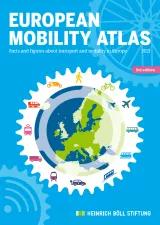European Mobility Atlas 2021
In italiano | En español | V češtině | Version française | Ελληνική έκδοση | Versão portuguesa
Read the web dossier | Download the folding map "Sustainable Transport Around Europe" in PDF or PNG version.
Sustainable transport and mobility are key to tackle the climate crisis and to achieve the targets of the European Green Deal. However, transport today accounts for nearly 30 percent of the CO₂ emissions within the European Union. How can the EU reduce its transport and mobility emissions while connecting citizens, creating green jobs and leading the innovation in the sector?
The new European Mobility Atlas 2021 by the Heinrich-Böll-Stiftung analyses the key facts and figures about transport and mobility in Europe, contributing to the efforts towards sustainable and just mobility in the European Union. Its chapters are devoted to different dimensions and policy-areas related to transport and mobility: railways, cycling, digitalisation, climate, Covid-19 and more.
Product details
Table of contents
IMPRINT
It took until the late 1980s to make transport part of EU policy. Since then, steps have been taken towards a more ambitious transport policy. Reluctance in EU Member States to enforce the rules keeps being the biggest obstacle.
Liberalisation and social harmonisation have barely gone hand in hand in the transport sector. Some EU rules exist, but without proper enforcement, the current employment situation is often unsatisfactory.
Suddenly, the skies were blue. The Covid-19 lockdown grounded the majority of flights, and analysts say that it could take years for aviation to get back to normal.
For more than 100 years, the automotive industry has relied on cars with internal combustion engines. Today, transformation is irrevocable. The Covid-19 pandemic makes it a truly Herculean task.
European transport infrastructure reflects the complexity of Europe's cross-border management tasks and its historic path dependency. Railway infrastructure is a prominent example of this.
A well-connected cross-border railway system is the backbone of European transnational mobility. Yet many cross-border points still look like a patchwork reflecting a myriad of different national systems.
Maritime transport is the most important, most efficient, but also dirtiest way of shipping goods. Not covered by the Paris Agreement, the industry is trying to set guidelines for a more environment-friendly maritime transport.
Tourism is a major economic sector in Europe. But its negative impacts on the environment and local communities raise concerns. Sustainable travel is growing, yet Covid-19 could change everything.
Unlike many industries, the manufacture of bicycles keeps on growing. This is mainly driven by the sale of e-bikes. The ever-increasing demand for them seems to be helping the industry to recover rapidly from the impact of Covid-19.
Cargo bikes play a big role in avoiding motorised transport of goods. Many European cities operate successful cargo bike subsidy schemes. Commercial use, private ownership, sharing - all forms of cargo bike use are on the rise.
Providing people with the options to safely walk, bike or use public transportation is paramount not only in creating a green and sustainable city, but also a liveable, people-friendly city.
Cyclists and pedestrians run a high risk of being killed in road traffic. At national and EU levels, a variety of initiatives aims to protect them better. However, more is needed to ensure effective pedestrian and cyclist safety.
The 'last mile' is often a key problem in public transport. Smartly planned intermodal intersections and digitalisation offer a range of possibilities to close that gap in the transportation chain - even with solutions for an individual mobility.
Inefficiencies in the transport system are caused by false prices. A high amount of costs is passed from the polluter to the general public. This 'externalisation' prevents fair competition in transport and must be changed.
The path going forward is clear: for road vehicles, electricity and alternative fuels will soon replace petrol and diesel. The climate protection potential of this move is high, but some problems still need to be solved along the way.
Detected five years ago, 'Dieselgate' remains partly unsolved, although national governments and the European Commission have offered a wide range of responses. Consumers criticise the scandal-handling by car manufacturers.
Increasing mobility and trade as well as the shortening of a vehicle's average life have led to a growing number of vehicles that have reached the end of their useful life in Europe.
Europe and the world have been hit by trans-national crises before the Covid-19 pandemic. And mostly all of them had a severe impact on mobility and transport.
Digitalisation has already changed urban micro--mobility. The next step is the development of a single app for all mobility services.
AUTHORS AND SOURCES FOR DATA AND GRAPHICS
ABOUT US
